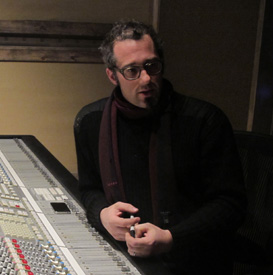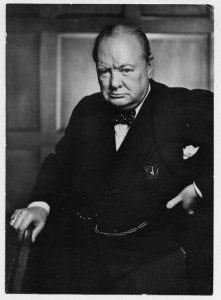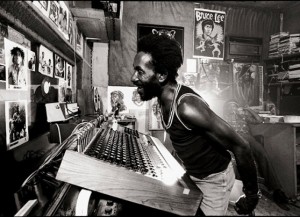The Quirky Habits of Great Mixers
Want to improve your mixing forever, for the better? Try Mixing Breakthroughs risk free for 30 days at MixingBreakthroughs.com
Anyone who has worked on enough records knows that it’s not the tools that make a great mix, but the way that they’re used. And in a day and age where great sounding audio gear has become something of a commodity—an assumed baseline rather than a unique and unusual selling point—the benefits of experience have become more valuable than ever.
Today, the most meaningful contribution a great mixer can make is in his or her choices, ears, experience, and perhaps most importantly, perspective. But if you ask even the most celebrated pros, maintaining that perspective isn’t always easy. Many of them have developed little mind games and quirky rituals that help to restore their focus.
Sometimes, it’s the little things that can take a mix from good to great. But they may not always be the little things that you expect…
Distract Yourself to Hear What Really Matters
Earlier this year, famed recordist Steve Albini [Nirvana, Pixies, The Breeders] told Reddit:
“When I first started making records I would sit in front of the console concentrating on the music every second. I found out the hard way that I tended to fiddle with things unnecessarily and records ended up sounding tweaked and weird. I developed a couple of techniques to avoid this, to keep me from messing with things while still paying attention enough to catch problems.”
“For a long time I would read, but it had to be really dry, un-interesting stuff. The magazine The Economist was perfect, as were things like technical manuals and parts catalogs. I had a stack of them by the console. It can’t be anything interesting or with a storyline like fiction because then you can get engrossed and stop paying attention to the session. It has to be really dull, basically, so you are looking for an excuse to put it down and do something else.”
“This has proven to be a really good threshold, so that if anything sounds weird or someone says something you immediately give it your full attention and your concentration hasn’t been ruined by staring at the speakers and straining all day.”
Not all of us have the cajones to read a newspaper in the middle of a tracking session, but Albini isn’t alone in this approach. Producer Fab Dupont [Santigold, Jennifer Lopez, Bebel Gilberto] tells us that he often reads while mixing on his own.
“If I get stuck, I like to just go sit elsewhere in the room and do something else while the track keeps running in loop,” Dupont says. “Usually I read the French news on my laptop and it allows me to switch to the other language side of my brain and hear the track in a different headspace.”
“If you think about it, we hear more music than we listen to music these days, and doing this often gives me great perspective on the track. After a few headlines – and thankfully usually just before I hit the sports section – something will strike me and give me new inspiration.”
Fans of the acclaimed TV show Mad Men may be reminded of Don Draper sitting silently in his office nursing a scotch, when his boss walks in and—showing that he’s well aware that this is just part of his star creative director’s process—remarks “I can never get used to the fact that most of the time it looks like you’re doing nothing.”
But you can also do this without the isolation—and without the scotch, too. Joel Hamilton [Blakroc, Tom Waits, Dub Trio] integrates the people around him into his distraction.
“I actually learned that there is a psychological term for the way I work,” he tells us. “It’s called ’Distraction/Focus‘ and I do it all the time.”
“I leave the mix at a conversational level, and let it play in the ‘background’ while I tell idiotic stories or rant about some obscure compressor I love and why, or just chat with someone in the room. Then I hear little things that stand out because my brain is occupied on the conversation, but really I am hearing the little things – smaller things than I hear when I am ‘staring at the speakers’ and really listening.
“I’ll do that all the time: Listen like it is someone else’s record for a while, just having a conversation – And then stop mid-sentence and move a fader down or up or whatever… and then go back to chatting.”
Stop Working and Get More Done
Sometimes you need more than just distraction while listening. Hard-working professionals know that their break time is just as important as their work time.
“Mixing digital has created the issue of no downtime for your ears,” says Bob Power, who has produced, recorded and mixed for iconic hip-hop and R&B artists like Erykah Badu, A Tribe Called Quest, D’Angelo, Macy Gray, India Ari, Meshell Ndegeocello and De La Soul.
“While the ability to loop playback has made many things much easier – like EQing a tom – the lack of rewind time doesn’t give one’s ears much of a rest. I tend to take more short breaks now than I used to. Having my dog with me in my studio helps with this – she needs walks.”
He’s not the only one who’s realized that sometimes, to stop working allows you to get more done. We also talked to Bob Clearmountain, an avowed napper who’s famous for mixing groundbreaking records for The Clash, INXS, Bryan Adams and Bruce Springsteen, and is still arguably one of the busiest mixers working today.
For him, stopping in the middle of the day to turn off the song, lay down on the couch and shut his eyes keeps him going and helps him get more work done.
But don’t just take it from Clearmountain. Winston Churchill was a napper, and he credits the practice for helping him to get Great Britain through World War II:
“You must sleep some time between lunch and dinner, and no half-way measures. Take off your clothes and get into bed. That’s what I always do. Don’t think you will be doing less work because you sleep during the day. That’s a foolish notion held by people who have no imagination. You will be able to accomplish more. You get two days in one – well, at least one and a half, I’m sure. When the war started, I had to sleep during the day because that was the only way I could cope with my responsibilities.”
We may never have to help lead a war-torn nation whose cities were being bombed into oblivion by the Nazis, but hey – It’s nice to know the stuff works.
We also may not always be able to take it as far as Churchill, especially when we’re in the room with our clients (“Hey – Do you guys mind? I’m gonna pull out the sofa and slip into my jammies.”) But the point is a good one.
Stop Mixing and Start Listening
I’ve often said that I do my best mixing when I’m not mixing. It’s nice to know that some of my favorite mixers agree. In a way, this habit is the reverse of, and a counter-balance to, the “distraction” method.
“When I’m fairly far along in the mix, upon returning from a longer break, I listen once through with no stops and write everything down that’s bugging me on a sheet of paper,” Bob Power tells me.
“Then, I go down the list, fixing things one by one. This helps avoid some of the ‘forest for the trees’ issues that often happen deep into a mix, while still allowing me to actually get things done.”
This is a common approach I’ve heard from many accomplished mixers. Some of the best ones learn it early. Zach McNees, who is barely in his thirties, cut his teeth assisting on sessions for Björk, Anti-Flag and John Legend, and has since mixed for notable indie bands like Enter The Haggis, who cleared an impressive $55,000 in their recent Kickstarter campaign.
“I always print my mixes and review them on my old iPod,” he says. “I’m just so used to the converter in that thing and my Sony 7506’s that I will sit down at the end of mixing a song or an album and listen through thoroughly and take lots of notes. I will usually try to listen outside the apartment too while walking on the street, and on the subway.”
My headphones are different, but this is one of my favorite ways to work as well. Many of the best mixers will tell you that sometimes when you get your hands off the faders and physically step away from the mix, you can suddenly listen more deeply, more fully, and hear things clearly that you might miss when you’re “zoomed in” to the mix.
Bob Clearmountain says that he likes to listen to a full pass away from the console, on the couch in the back of his room, before he prints. He also mentions that some studio designs don’t account for this approach and foolishly hide their couch behind an island gear rack or in a place where it acts as a bass trap. When he designed his mixing space, Clearmountain was sure to make it so that the couch also sat in a trustworthy sweet-spot.
Once notes are collected away from the mix, it’s easy to make a checklist, go through the changes, and then step away from the mix once again to hear the big picture.
Bonus Tip 1: Listen Low, Listen Everywhere
There are some great side benefits to stepping away from the console too.
Bob Power says, “I find it helpful to listen to a mix off-axis of the speakers, or from elsewhere in the room, as this will sometimes show you balance issues or vocal rides that you can’t hear as well in front of the speakers. The low end tends to divert our attention from some things.”
Zach McNees adds: “I tend to switch over to my headphones at a certain point in the mix and spend a couple hours working there. So much of the public listens to albums on headphones these days. And in general, I adhere to the Chris Lord-Alge notion that if you can make a mix sound amazing at low volumes, it will almost always sound amazing cranked up.”
Listening on a variety of speakers and monitoring at low volumes is so commonly advised that we’re just not sure it qualifies as “quirky” to most audio professionals. But Geoff Sanoff, one of the hosts of the Input\Output podcast, and chief engineer at Stratosphere Sound, has tried some novel approaches to get a sense for what mixes will sound like on consumer systems.
He advocates using Rogue Ameoba’s Airfoil program to stream your mix directly to an iPad or smartphone and listen to your sounds on their built-in speaker. This is a growing platform for audio, and although it may be one he laments, it’s also a platform he likes to be prepared for.
Bonus Tip 2: Mix Standing Up?
Okay. This is one that hasn’t caught on – Yet. But who knows?
The Dub-Reggae pioneer Lee “Scratch” Perry had his console mounted high up off the ground, its legs stacked on bricks, so that he could mix standing up and dance to his mixes as he worked on them.
Since he’s known for his adventurous use of rhythmic effects that he would change and morph in real-time, there’s a good chance that moving to the music helped him mix better and stay in tune and in time with the song. Perry’s mixes were performances in the truest sense of the word. And in a world with ever-greater automation, maybe standing up can give us a “leg up”, so to speak, on keeping things organic.
But there may be more to it than that. Today, doctors are beginning to say that “sitting is the new smoking,” and have shown that our increasingly sedentary lifestyles are doing much to shorten our lifespans and our quality-of-life as well.
I talked to Bob Clearmountain about this and he said he’s been curious about this idea for some time. For now, his first step will be to raise his desk slightly, as he’s found that stooping down in his chair can be a pain in the back.
None of the mixers I’ve talked to have tried turning over to standing desks yet, but there’s a chance that in the future, we may break our shackles and get off our butts. Standing desks are already a growing trend for other types of creative professionals and office workers who can design their own workspaces. There’s a precedent for it in mixing as well: How often do you see a live sound guy sitting down?
I can’t say if this one will catch on – But call me quirky, because I’m going to try it. This month, I put my old desk in a closest and changed my home rig over to a standing setup. We’ll see how it works, and who knows? Maybe someday I’ll come back with a quirky tip of my own.
Justin Colletti is a mastering engineer who writes and talks about music, sound and how we make it.
This article was originally published August 9th, 2012. We are republishing it to help our newer subscribers.
Want a complete roadmap and proven system for mixing? Try Mixing Breakthroughs risk free for 30 days at MixingBreakthroughs.com
Please note: When you buy products through links on this page, we may earn an affiliate commission.











Ira
September 6, 2012 at 3:59 pm (12 years ago)cool article Justin! I posted a link on my Forum,
I’ve been enjoying the newsletters, keep up the good work
Ira
Daniel Meyer
September 7, 2012 at 8:44 am (12 years ago)Beautiful article.
I mix standing up and sitting on the floor.
Laptops. 🙂
Royalston
October 7, 2012 at 9:39 pm (12 years ago)One of the most relevant and useful articles I’ve read on mixing in years. Thanks!
Gregg Mervine
April 23, 2013 at 10:19 am (11 years ago)I began using a stand-up desk last month. It’s awesome. I can move around as I work, I don’t slump over and then reach for things from a contorted position, I move a bit to the music and feel more energetic, and, when I need to break, I sit down in a couch or recline in a hammock, read the news, make a phone call or something. it’s much better than before, when I’d work sitting down, get lethargic (not tired), and, to take a break, I’d stand up, stretch, smoke a cigarette on the veranda, and then come back to sitting.
Louis Sherman
August 22, 2013 at 11:41 am (11 years ago)I have been using a standing desk for mixing since day 1 and I have to say that there is nothing more freeing than being able to “dance” the mix or at least move about and shift your focus a bit, it also helps with the client as they can come over and lean on the desk and chat about the details both standing as if at a bar. Very nice and positive set up! Highly recommended!
RANDALL
September 10, 2013 at 10:05 am (11 years ago)I can’t mix sitting down. I can’t reach all the knobs lol. I also feel like I can’t put energy into a mix while sitting down. My problem is mixing in the box where all my controls are sitting. But you’ll see me with my butt slightly off the seat trying to bring the energy forward. A relaxing mix though, and half the time I’m on the back couch just listening.
Heavy Empty
May 29, 2014 at 5:45 pm (10 years ago)are you still using the standing desk? i’ve converted to it recently and fell in love. I sit so much during the day anyway, and then there is sleeping, so…thinking standing while I work is going to be healthier in the long run. Just curious if you’re still on it Justin! Thanks for the great articles. Really enjoy reading them. http://soundcloud.com/theHeavyEmpty
Lenny Blandino
September 30, 2016 at 10:05 am (8 years ago)Great article Justin! Standing up is good, especially after a lot of Italian food! 🙂